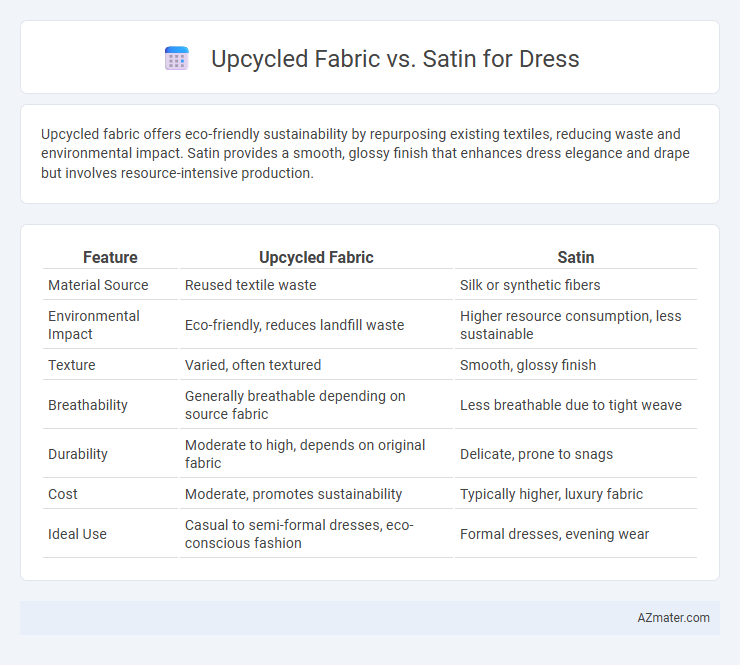Upcycled fabric offers eco-friendly sustainability by repurposing existing textiles, reducing waste and environmental impact. Satin provides a smooth, glossy finish that enhances dress elegance and drape but involves resource-intensive production.
Table of Comparison
| Feature | Upcycled Fabric | Satin |
|---|---|---|
| Material Source | Reused textile waste | Silk or synthetic fibers |
| Environmental Impact | Eco-friendly, reduces landfill waste | Higher resource consumption, less sustainable |
| Texture | Varied, often textured | Smooth, glossy finish |
| Breathability | Generally breathable depending on source fabric | Less breathable due to tight weave |
| Durability | Moderate to high, depends on original fabric | Delicate, prone to snags |
| Cost | Moderate, promotes sustainability | Typically higher, luxury fabric |
| Ideal Use | Casual to semi-formal dresses, eco-conscious fashion | Formal dresses, evening wear |
Introduction to Upcycled Fabric and Satin
Upcycled fabric is crafted by repurposing pre-existing textiles, reducing waste and promoting sustainability in fashion design. Satin, a smooth and glossy weave typically made from silk or synthetic fibers, is prized for its luxurious appearance and drape. Comparing upcycled fabric and satin for dresses highlights differences in environmental impact, texture, and aesthetic value.
Environmental Impact: Upcycled Fabric vs Satin
Upcycled fabric significantly reduces environmental impact by repurposing existing materials, minimizing waste, and lowering resource consumption compared to conventional satin production, which often involves intensive water use and chemical processing. The carbon footprint of upcycled fabric is substantially lower due to decreased reliance on new raw materials and energy-intensive manufacturing processes typical of satin. Choosing upcycled fabric supports sustainable fashion practices by promoting circularity and reducing pollution associated with synthetic or traditional satin textiles.
Texture and Feel: Comparing Comfort Levels
Upcycled fabric offers a unique texture that varies based on the original textile, often providing a more breathable and eco-friendly option compared to satin. Satin is known for its smooth, glossy surface that feels luxurious and cool against the skin but may trap heat, making it less comfortable in warm conditions. Both materials cater to different comfort preferences, with upcycled fabric excelling in softness and sustainability and satin delivering sleekness and elegance.
Style Versatility: Design Possibilities
Upcycled fabric offers unique style versatility with its diverse textures, patterns, and eco-friendly appeal, enabling designers to create one-of-a-kind, sustainable dresses. Satin provides a smooth, glossy finish ideal for elegant, formal wear and allows for fluid draping and structured silhouettes, enhancing sophisticated design possibilities. Both materials support innovative fashion designs, but upcycled fabric emphasizes individuality and sustainability, while satin focuses on classic luxury and refined aesthetics.
Durability and Longevity of Each Material
Upcycled fabric typically offers enhanced durability due to its often heavier weaves and reinforced fibers, making it resistant to wear and tear in everyday dress use. Satin, while luxurious and smooth, tends to be more delicate with a higher propensity for snagging and abrasion, reducing its longevity under frequent wear. Choosing upcycled fabric can result in a more sustainable and long-lasting dress option compared to satin's elegant but less durable nature.
Cost Analysis: Upcycled Fabric vs Satin
Upcycled fabric typically offers a lower cost option for dressmaking due to its reuse of existing materials, reducing raw material expenses and environmental impact. Satin, especially high-quality silk satin, tends to be more expensive because of its production process and the cost of fibers used. Choosing upcycled fabric can significantly reduce overall dress costs while maintaining unique aesthetics compared to the luxurious but pricier satin fabric.
Ethical and Sustainable Fashion Choices
Upcycled fabric reduces textile waste by repurposing existing materials, significantly lowering environmental impact compared to traditional satin production, which often requires intensive water and energy use. Choosing upcycled fabric supports ethical fashion by promoting resource conservation and reducing landfill contributions, while satin, typically made from polyester or silk, involves more complex supply chains with greater carbon footprints. As consumer demand grows for sustainable fashion, upcycled fabrics offer a responsible alternative that aligns with eco-friendly and cruelty-free values.
Maintenance and Care Requirements
Upcycled fabric requires gentle washing with mild detergents to preserve its unique textures and patterns, often benefiting from air drying to prevent shrinking or color fading. Satin demands delicate handling, typically hand washing or dry cleaning, to maintain its smooth, glossy finish and prevent snagging or water spots. Both fabrics necessitate careful storage away from direct sunlight to prolong their quality and aesthetic appeal.
Popular Fashion Trends: Upcycled vs Satin Dresses
Upcycled fabric dresses are gaining popularity for their sustainability and unique textures, aligning with eco-conscious fashion trends. Satin dresses remain a classic choice, prized for their smooth, glossy finish and elegant drape often seen in formalwear collections. The contrasting appeal of upcycled fabric's environmentally friendly story versus satin's luxurious sheen highlights evolving consumer preferences in modern dress designs.
Making the Right Choice for Your Dress
Upcycled fabric offers an eco-friendly and sustainable option for dressmaking by repurposing existing textiles, while satin provides a luxurious, smooth texture that enhances elegance and drape. Choosing between upcycled fabric and satin depends on your priorities: opt for upcycled fabric to minimize environmental impact and support sustainable fashion, or select satin for its classic sheen and formal appeal. Consider factors such as event type, comfort, and personal style to make the right choice for your dress.

Infographic: Upcycled fabric vs Satin for Dress
 azmater.com
azmater.com